When KTM invited Cycle World to the Rattlesnake National Enduro in Cross Creek, Pennsylvania, I had the pleasure of testing most of the Austrian company's range of serious race-ready trailbikes, both two-strokes and four-strokes. On the tight, technical and rocky trails used by the Brandywine Enduro Riders, where there was just enough rain to make it sometimes nasty and always fun, one of the bikes really stood out: the 2014 KTM 200 XC-W.
The $7599 200 really is a star player in the XC-W lineup, largely because it's the only two-stroke readily available in this displacement class. For a lot of riders, especially smaller guys and kids growing out of minis, it's the best choice. KTM updates the 200 each year, and the 2014 model shares all of the model-line improvements with the other XC-Ws.
Last year, the addition of electric start was the finishing touch that brought the 200 XC-W into full-featured glory. This year, the starter and battery have been made stronger. Over the past few years, engine refinements in durability and power have the two-stroke motor pulling from lower and lower rpm, while revving out plenty far as well. The chassis, like that of the other XC-Ws, has been upgraded, and the bike now sports a revised front fender, a bottom triple-clamp with altered mounting holes, new handguards and a better headlight (using a common H4 bulb) that actually shines light where you need it. Finally, stiffer seat foam is said to last longer and be more comfortable.
Why would a 200 two-stroke that practically starts when you look at the kickstarter need electric starting and the roughly eight pounds it brings along for the ride? For those silly enough to ask, here’s my answer: “If you can’t understand it, you can easily take it off.” At any rate, the starter works great, and the 200 XC-W fires up like every bike should. The new jetting is crisp, though we tinkered with the air screw to find perfection off the bottom. And after trying a different setting, it’s obvious that, as with adjusting the powervalve spring tension, the jetting can play a large role in power delivery as well. The stock setting is lean, which works well for drivability and smooth pick-up without need for any clutching. Bogging was noticeably rare on this bike, even with big throttle openings and revs.
The 200, over the last few years, has improved into a mini 300 of sorts, totally happy just lugging around a gear high, and never really getting into the powerband (where the powervalve opens and makes things interesting). But it will still run there, and that’s the key to going fast and making time on the trail. In other words, racing. The 200 XC-W has more torque than a 250 four-stroke in the crawl level, and its claimed weight of 220 pounds (that’s 12 lb. less than the 250 XCF-W) is a real advantage. The 200, it should also be noted, is the last XC-W to have a spring-type clutch, a durable design with light lever action.
We tried a richer setting (162 main jet, 42 pilot jet, NOZI needle in the middle clip), and this gave the bike a beefier pull through the mid-range and definitely more go on top with just a little loss of response at the bottom of the power spread. Although it’s definitely a better race setting (stock is better for trail riding and fuel economy), it showed that the 200 can be as ferocious as necessary.
The biggest advantage of 200 is its light feel. In technical going, it feels even lighter than a 125 because of the extra torque and the ease with which the motor gets, and keeps, you moving. Then, when you are on the throttle and using the power, you’ll soon learn that the fast way to ride the 200 is to shift gears frequently. The six-speed transmission has tight ratios, with a spread that lets the engine work hard in first or sixth.
Although the suspension feels set up for a 150- to 170-lb. rider, it easily worked on either side of those weights with a little tuning. This 200, like all the XC-Ws, feels plush and active on the small stuff, but with enough progression in the stroke to stiffen up and resist bottoming as necessary. With a heavier rider, the 200 feels extra plush and almost as planted as the four-strokes. With a lighter rider, I’m sure the 200 would take on the slightly more “dancy” feel the bigger two-strokes exhibit. Again, adding high-speed compression to the shock (one-quarter turn is all) puts more weight on the front wheel; taking some out boosts stability, depending on your preference.
Factoring in its light weight, light-effort steering and insanely good brakes, the new 200 XC-W for 2014 is a super fun way to attack your favorite trails, and solid proof that KTM has once again upped the ante in the off-road game.
View full-size images in photo gallery:










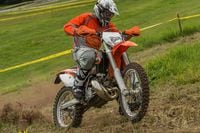
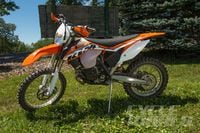
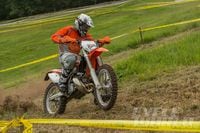

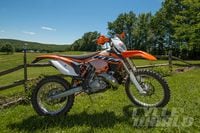
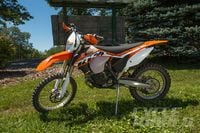
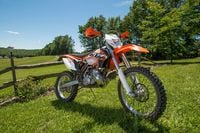
/cloudfront-us-east-1.images.arcpublishing.com/octane/HMC5X3JZHRASXGVCVNBJBWWGSI.jpg)
/cloudfront-us-east-1.images.arcpublishing.com/octane/UIWGXRZDM5HZXJOWXET2DZIWJE.jpg)
/cloudfront-us-east-1.images.arcpublishing.com/octane/QSS5DZ6SKJEU3AKE4KDAWYBEFY.jpg)
/cloudfront-us-east-1.images.arcpublishing.com/octane/SMCEQCLWRVEFTJJES6TAHB3OOQ.jpg)
/cloudfront-us-east-1.images.arcpublishing.com/octane/JCACIDCAC5FUNPTXO2BOUHGGII.jpg)
/cloudfront-us-east-1.images.arcpublishing.com/octane/DC7ZGILA2BCJXHZIUNYGV7JSEA.jpg)
/cloudfront-us-east-1.images.arcpublishing.com/octane/EWJEZUGWEZGABDEQWB64WL46GQ.jpg)
/cloudfront-us-east-1.images.arcpublishing.com/octane/5NHBMRMSFVD5JAPFNMBMNPGXQE.jpg)
/cloudfront-us-east-1.images.arcpublishing.com/octane/WHE43SCPLJBRNANAJAGXHOAIEU.jpg)
/cloudfront-us-east-1.images.arcpublishing.com/octane/6R56AQAW6NDE7BBIJ3SMCOOY5A.jpg)
/cloudfront-us-east-1.images.arcpublishing.com/octane/JMQTUE2FKZFURJTJXDMM4V47AQ.jpg)
/cloudfront-us-east-1.images.arcpublishing.com/octane/P2QYJDMQNVEANMQFXHNB3OVFKQ.jpg)
/cloudfront-us-east-1.images.arcpublishing.com/octane/VNKGXM4AA5BPRGERJOPV6GADAQ.jpg)
/cloudfront-us-east-1.images.arcpublishing.com/octane/2WS4YIFLTNG25L25WP7ZFLSWJM.jpg)
/cloudfront-us-east-1.images.arcpublishing.com/octane/UXRS6ZVQZFC23FY2EDYNT5WMVA.jpg)
/cloudfront-us-east-1.images.arcpublishing.com/octane/7JETMCKNVRGDZIGB3JCITGLPUU.jpg)
/cloudfront-us-east-1.images.arcpublishing.com/octane/OZV6E2KNIJDVHGOKXQQ2AHKLHQ.jpg)
/cloudfront-us-east-1.images.arcpublishing.com/octane/XSKMIBFZIZDN7JC6P7SMNMD3QA.jpg)
/cloudfront-us-east-1.images.arcpublishing.com/octane/ITVHWHVQ75BQBHACERYDJLPLHE.jpg)
/cloudfront-us-east-1.images.arcpublishing.com/octane/M3QRBSQ4VFEVPKYTTM3OETVFBU.jpg)
/cloudfront-us-east-1.images.arcpublishing.com/octane/H3EMT5NJ5BDZPBBH27SW3ADQH4.jpg)
/cloudfront-us-east-1.images.arcpublishing.com/octane/XTROSHDZFJB5DIJYU2VF2REFIU.jpg)
/cloudfront-us-east-1.images.arcpublishing.com/octane/7EUSM4GQEBEFTPAYZ6MOMKMMUQ.jpg)
/cloudfront-us-east-1.images.arcpublishing.com/octane/ZN44KZLHD5CHVIY3WZYAGTPGSI.jpg)